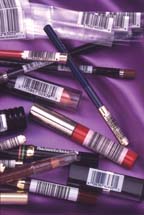Packaging = Security at Pack EXPO Las Vegas 2003

Dairy processors, like other manufacturers, can't be too careful these days. In times of bioterrorism, tampering, counterfeiting and shoplifting, no area is immune from these brand-damaging, sales-sapping activities.
Fortunately, there are steps manufacturers can take to protect their products from harm. Often the cost is minimal, but even when it's not, benefits likely outweigh the expense. Protected products generally enjoy higher sales and are less likely to be involved in an incident that could erode brand equity and perhaps bankrupt the brand owner.
Several innovative advancements designed to counter threats to brands and consumers will be featured at this fall's PackEXPO Las Vegas 2003, October 13-15, at the Las Vegas Convention Center. Sponsored by the Packaging Machinery Manufacturers Institute (PMMI), many of these new technologies will be displayed as part of a special Containers & Materials Pavilion.

Sophisticated Countermeasures
To effectively safeguard products, packagers tend to use multiple countermeasures. This not only enhances protection, but also discourages the criminals that prey on the most vulnerable targets. "Packagers are looking for more sophisticated products that incorporate an array of protective devices and different levels of protection," says Richard Zucker, executive v.p. of DuPont Authentication Systems, Bridgeport, Conn. (Booth No. S-4992).Protective measures often combine overt and covert devices. The former are easily recognized by consumers as tamper-evident or authentication devices, and include options like shrink bands and sleeves, induction seals over bottle necks, clamshells, holograms, micro text and sequential coding. Covert devices provide tools for in-house security or law enforcement personnel to confirm authenticity and identify situations where a product is not where it is supposed to be. Examples include ultraviolet- or infrared-light visible alphanumerics, microscopic nanotext, intentional errors, temperature-triggered thermochromic ink, and microtaggants, which allow packaging materials to be "fingerprinted." Such covert devices have high appeal for marketers since their presence has little or no impact on a package's graphic design.
Security Seals
Sealed packaging provides protection against a myriad of hazards. Depending on the method selected, sealing can discourage tampering, counterfeiting or pilfering and may counter more than one problem at the same time.
One of the most familiar sealing methods is shrink film applied as a wrap, band or full-body sleeve, which generally consists of unprinted or printed polyvinyl chloride, oriented polystyrene or polyethylene terephthalate glycol film. Sleeves run from the base of containers to the top of closures and typically are vividly printed in eight or more colors to perform double duty as product labels. This design enhances shelf appeal by providing a 360-degree surface for graphics.
Simpler sleeve designs also can accomplish multiple tasks by carrying the product bar code and providing tamper evidence for items like eye-liner pencils and lipsticks.
Shrink bands, which generally cover closures, often are custom colored or printed with logos or other messages to make duplication more difficult. For added distinction, SleeveCo, Inc., Dawsonville, Ga. (Booth No. S-5235), can convert holographic material into shrink bands or sleeves.
There are two schools of thought as to whether bands should be difficult or easy to remove. "Some companies feel a band that's difficult to remove provides a greater level of confidence that the product has not been touched," explains Sharon Lobel, president of Seal-It, Inc., Farmingdale, N.Y. (Booth No. C-450), a supplier of shrink bands and sleeves. However, if a packager wants an easy opening option, bands can be perforated and/or tabbed. It should be noted the perforated design can enhance tamper evidence by increasing the band's fragility to the point it disintegrates upon removal so it's impossible to reposition it around the cap.
Another type of tamper evident sealing, particularly for cartons and corrugated shippers, is tape. An almost infinite number of variations is possible when all the different combinations of materials, colors and levels of adhesive aggressiveness are considered. A new design from SHEP Co., Lawrence, Mass. (Booth No. S-5254), addresses tamper evidence requirements through the use of temperature-sensitive ink, which changes color or reveals a hidden graphic when the material is exposed to a particular temperature. The covert device also can be used for authentication purposes.
3M, St. Paul, Minn. (Booth No. S-5001), delivers pilfer protection and brand identity with custom-printed, polypropylene box-sealing tapes. "Tape printed with messages, logos or company names makes it harder for tampering to go unnoticed as the tape is harder to duplicate," notes Wendy Benson, market development mgr. "We also provide a selection of standard designs with security lines that provide a clear indication a box has been opened because the lines fail to match if the box has been slit down the center." Various combinations of backing thicknesses, adhesive types and adhesion strengths may be specified. 3M also offers a stock security sealing tape. ScotchR Security Message Box Sealing Tape 3779 features the diagonal line pattern as well as the message, "CHECK SEAL BEFORE ACCEPTING."
Induction Sealing
Induction sealing uses an electromagnetic field to adhere a membrane to container openings at speeds of up to 800 per minute. The resulting hermetic seal not only provides tamper evidence, but also prevents leaks, protects product freshness and deters pilferage. Sealing is accomplished by passing capped containers under an electromagnetic sealing head which generates heat to release the membrane seal from the closure liner and adhere it to the lip (land area) of the bottle.
"The concept hasn't changed much over the years, but the equipment is smaller, more efficient and lower cost today," reports Bill Zito, v.p. Cap Sealing Sales, at Enercon Industries Corp., Menomonee Falls, Wis.(Booth No. C-1736). "The majority of packagers have switched from water-cooled systems to air-cooled. Advances in electronics and sealing head design allow air-cooled units to be more efficient and still maintain power requirements," he explains.
Pack EXPO Show Details
Pack Expo Las Vegas 2003 offers total access to today's state-of-the-industry innovations in packaging-including containers, materials, machinery, security solutions and more-all under one roof.As if that weren't enough, this year's show also marks the debut of the Containers & Materials Pavilion; more than 50,000 sq ft of floor space completely dedicated to innovative containers and materials. Included is the Showcase of Packaging Innovations, a must-see gallery of this year's award-winning package designs.
Plus, bring yourself up to speed on today's most pressing packaging issues by attending our renowned Conference at Pack Expo, a series of info-packed seminars led by the most esteemed names in the industry.
And as always, attendees will get double the value for every minute spent at the show because Pack EXPO Las Vegas 2003 is conveniently co-located with the Food Processing Machinery EXPO-a comprehensive collection of today's most innovative food processing exhibitors.
Location
Las Vegas Convention Center, 3150 Paradise Road, Las Vegas, Nevada
Exhibit Hours
October 13, Monday 9 am - 4 pm
October 14, Tuesday 9 am - 4 pm
October 15, Wednesday 9 am - 4 pm
New for 2003
Pack EXPO Las Vegas has created a new Containers & Materials Pavilion for 2003. Located in the front of the South Hall, this exhibit area will feature the latest innovations in materials, containers, and converting machinery.
Registration
Visit www.packexpo.com. or call 301/694-5243.
Looking for a reprint of this article?
From high-res PDFs to custom plaques, order your copy today!





